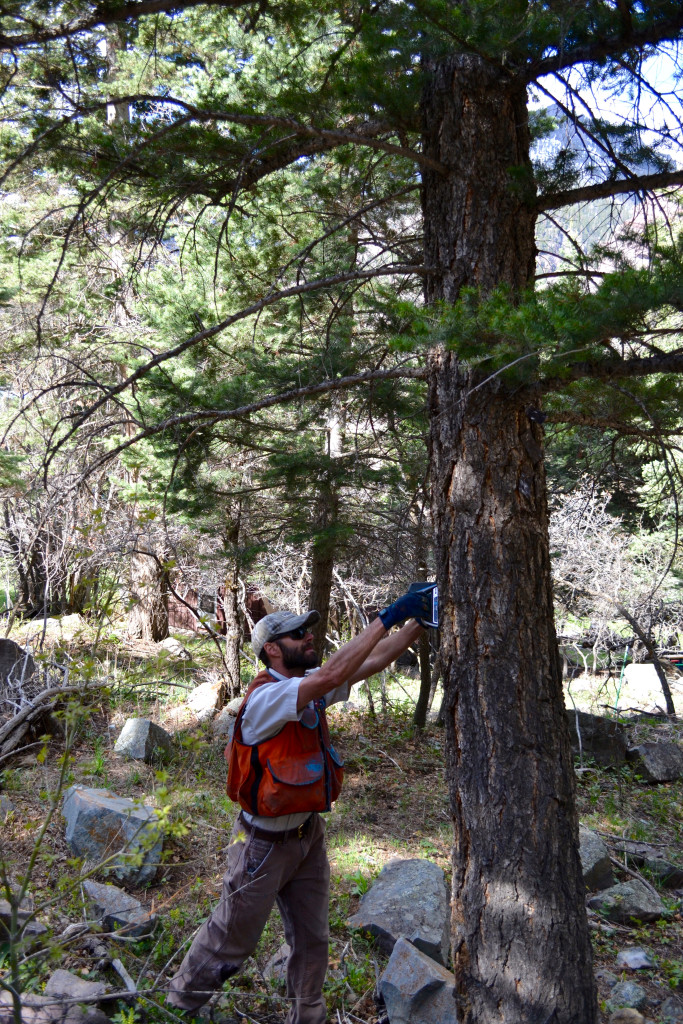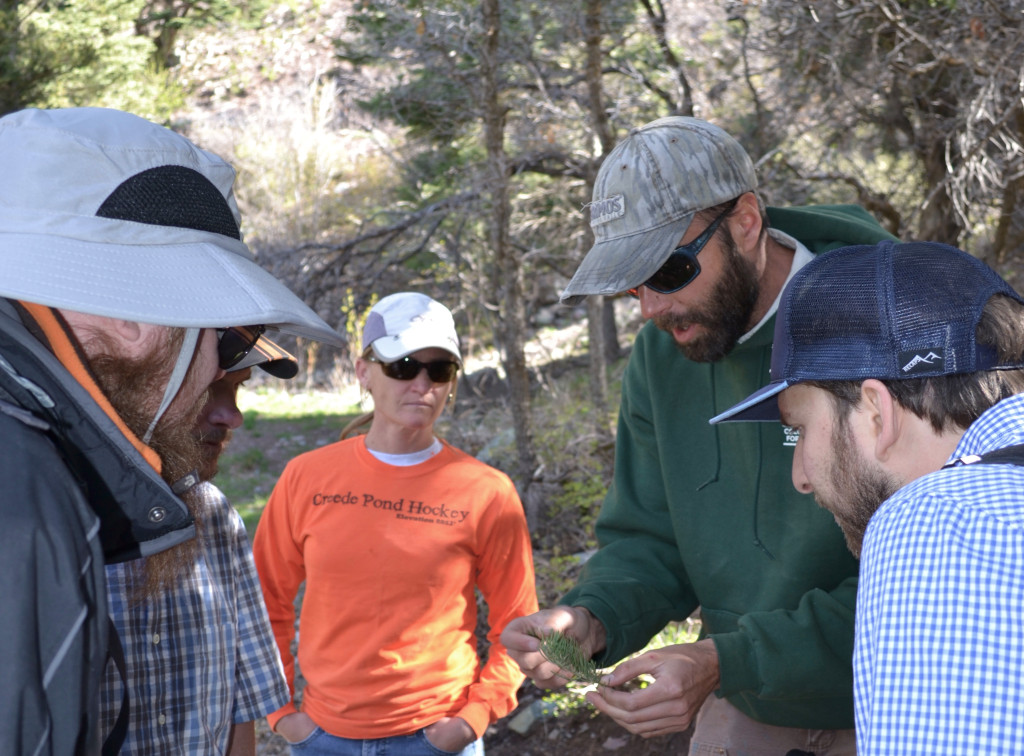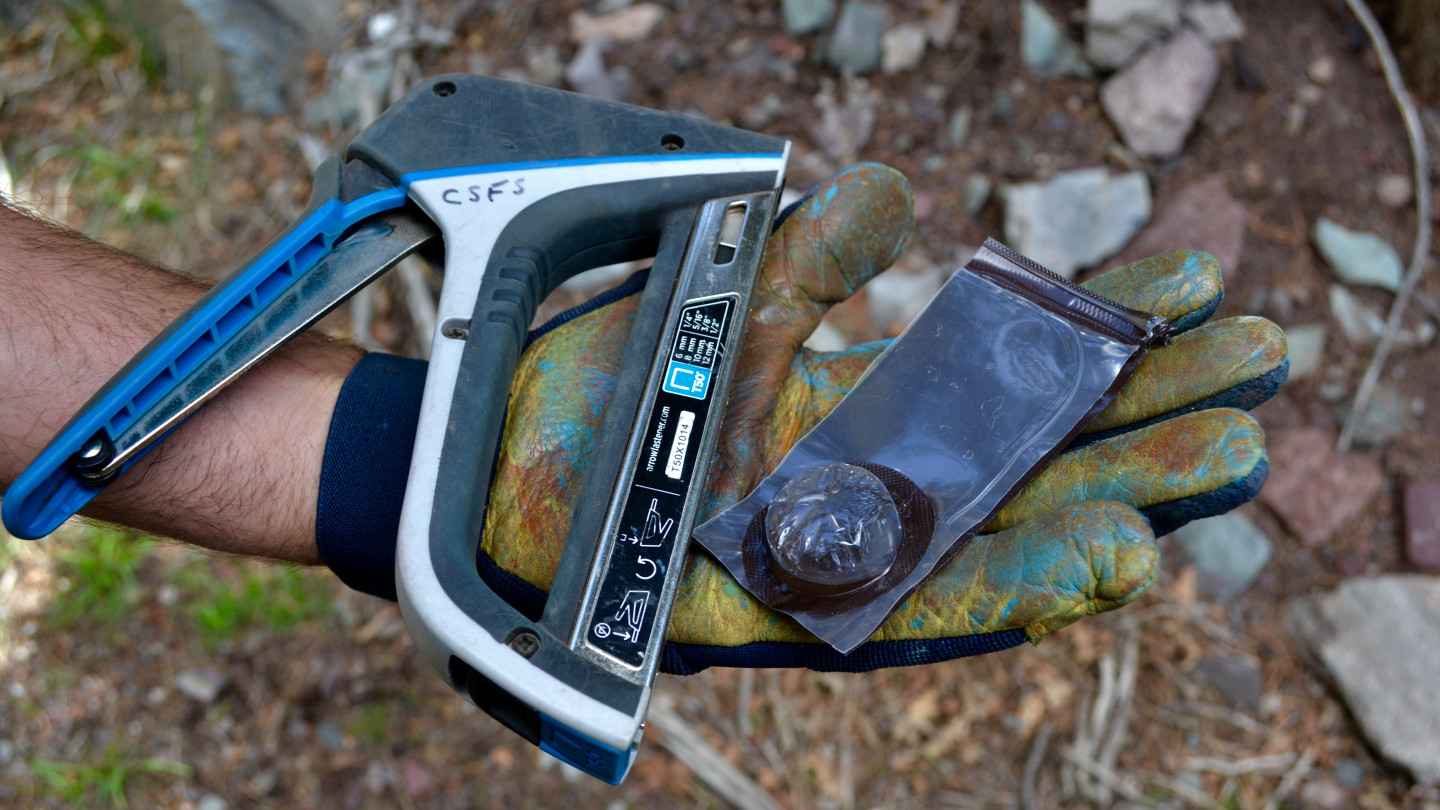Forester Austin Shelby holds a “bubble cap” or packet of chemicals developed to mimic pheromones that fool Douglas fir beetles into avoiding trees as they emerge and seek new hosts this spring. The packets are stapled onto the trees individually. This year, trees in the City of Ouray as well as on federal forest lands have been targeted for the application. (Erin McIntyre, Ouray County Plaindealer)
These are not the trees you’re looking for.
That’s the message sent by the scent wafting from Douglas fir trees on Ouray’s perimeter.
The smell emanates from bubble packs stapled to the trees. The packs contain chemicals that mimic the pheromones pine beetles use to send messages to each other. This time, the message is that they should keep on truckin’. Like a Jedi mind trick delivered by Obi-Wan Kenobi, this pungent mixture, smelling of tires and syrup, fools the tiny insects into thinking these trees are already taken. They’re dying. There’s nothing to see here.
Volunteers Shawn Kitchens and Aaron Silverman of Ouray and Robert Gaspari of Ridgway joined Colorado State Forest Service Forester Austin Shelby and Supervisory Forester Jodi Rist on May 7 to hang the pungent ornaments on the trees. Their goal is to apply 700 packets to Douglas firs in the area.
The chemical, MCH, is an anti-aggregation pheromone developed to mimic the beetles’ pheromones. The MCH sends the same message the insects’ bodies do in nature, deterring other beetles from congregating at that tree.
Like most fir, spruce and pine beetles, the Douglas fir beetle is a specialist preferring just one species of tree. While other parts of Colorado have endured vast beetle-kills in their forests, this is a different species of insect than the mountain pine beetle attacking lodgepole pines along Interstate 70, where there aren’t as many other kinds of trees to break up the landscape, quickly turning brown with dead and dying trees. Unlike the single-species forests covering whole mountains in other regions of Colorado, the forest around Ouray is more diverse, so the entire landscape won’t be wiped out by one type of bug.

That’s one of the reasons this might be a winnable battle for those trying to protect the Douglas fir trees. The forest diversity also helps, because beetles must travel farther from host tree to host tree than they would if the forest had a monoculture of the species they prefer.
This year, the City of Ouray paid the Colorado State Forest Service to purchase the pheromones in bulk and apply them to the trees on the city’s perimeter, spending just more than $1,500 for the chemicals. Foresters have applied the pheromones to the trees in the area every spring for at least five years, and say they appear to be working.
MCH was first identified in the beetles in 1971 and has been used by foresters in the U.S. since 2000, when it was approved for use by the Environmental Protection Agency, according to the U.S. Forest Service.
“One of the entomologists I work with says it’s the one magic trick that we have,” said Todd Gardiner, a Grand Mesa, Uncompahgre and Gunnison National Forest sylviculturist who works mostly in the Ouray and Norwood districts. “It’s over 90% effective.”
Foresters have targeted Douglas fir trees for protection in well-used areas and near campgrounds in recent years, Gardiner said. The trees around the Ouray Amphitheater and campground received their stapled packets of pheromone earlier this month, as did trees along other popular trails and recreation areas near Ouray and Telluride.
The volunteers working with Shelby and Rist were hoping to cover the area near Cascade Falls. They armed themselves with the stinky packets, loaded their staple guns and hiked up the ridges to the Douglas fir trees. Then they stapled the bubble packs as high on the trunks as they could reach. The packs are placed on the north sides of the trees to help shelter them from the sun and make the chemicals last longer.
Some pheromone packets were applied in a grid pattern in previous years, covering a certain density in the forest instead of targeting firs. Foresters have since determined hanging the bubble packs directly on the firs is more effective in this particular mixed forest, Shelby said.

That’s why he spends time with volunteers explaining identification methods before they hike up the hill, to make sure they’re affixing the packets to the right trees. Timing is also important, as the pheromones have to be in place to confuse the beetles during their flight period after the weather warms up and they emerge. The just-right time is when nighttime temperatures don’t dip below freezing for two consecutive weeks, according to Shelby.
For some, it might be hard to believe that such a tiny insect, about the size of a ballpoint-pen tip, can destroy trees towering more than 100 feet tall.
Their damaging habits come from gouging through the bark, tunneling under the bark surface into the cambium of the tree trunk. The females tunnel through this layer to lay their eggs, and the tunnels they create cut off the tree’s life-giving supplies of nutrients. This creates die-off in the upper branches and eventually kills the whole tree. Douglas fir beetles prefer the largest, oldest trees in dense stands, according to studies from the U.S. Forest Service, which reports that trees in stands at least 120 years old with at least 14-inch diameter trunks are most susceptible.
While insecticidal sprays have proven effective for preventative treatment during the same flight period for the beetles, they’re not practical on a large scale because they have to fully cover the trees.
“That treatment is for someone who has their favorite 200-year-old Douglas fir tree in their yard that Grandma is buried under,” Shelby said.
Though foresters have found the pheromones to be effective in preventing the spread of the infestation, they preach “active management” as the best method for slowing the beetle’s encroachment. This means removing dead or diseased trees — “if it’s brown, cut it down” — and not letting the freshly cut fir stay on the forest floor, where Shelby says it provides brooding ground for the beetle.
Active management also includes thinning to provide a healthy environment for trees. Rist said this is why residents might notice foresters removing trees, as they did about four years ago across 27 acres in and around Ouray. They also might notice foresters selecting trees for removal that leave multi-generational stands of trees, which helps protect against pests that prefer a certain age of trees from wiping them out.
The Ouray area has seen a decline in Douglas fir beetle activity In recent years, according to an aerial detection survey published by the U.S. Forest Service. In fact, results show a 100-acre decrease in the affected area from 2017 to 2018. Overall, the number of acres affected by the fir beetle remained steady at 14,000 acres across Colorado in the same period of time. The Grand Mesa National Forest has seen a 70 percent decrease in the number of acres affected by the Douglas fir beetle in the same time period, according to the survey.
Though MCH is labor-intensive to apply, it’s been a winner in the toolbox for foresters trying to protect individual trees from beetle infestations in the battles they can afford to choose, Gardiner said.
“If we have 1,000 bubble caps, that’s going to protect 1,000 trees,” he said. “It’s just a small postage stamp on the landscape, but it works.”
“I think we’re winning the battle with the trees we’re protecting,” Shelby said. “But on a large scale, the beetle’s going to have its way with the landscape … that’s kind of how nature works.
Erin McIntyre is copublisher of the Ouray County Plaindealer. This story was first published in the May 2, 2019, edition of the paper.













